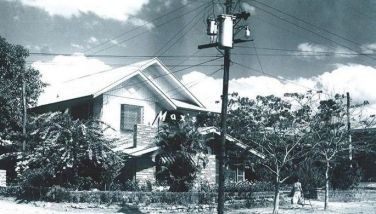Save the Tamaraw

There’s something special about the tamaraw. It’s a purely Filipino animal, endemic to Mindoro. Nowhere else is the tamaraw, also known as a dwarf buffalo, found in the world. The tamaraw is a smaller and bulkier version of the carabao or water buffalo, recognizable by its thick V-shaped horns.
World Wide Fund for Nature (WWF-Philippines) vice-chairman Jose Maria Lorenzo Tan said about 10,000 tamaraw used to roam in Mindoro over 100 years ago. But with the outbreak of disease and the lust of game hunters, only 327 are known to exist today. The International Union for the Conservation of Nature has classified the tamaraw as critically endangered, the highest risk rating for any animal species.
The remaining tamaraw can be found in the thick forests of Mounts Iglit, Baco, Aruyan and Calavite in Mindoro. Conservationists are alarmed that the tamaraw will go the way of the American bison – the mighty buffalo that was a Wild West icon in the late 1800s. It was estimated that there were over 100 million American buffalo in the so-called Great Plains in 1830. Native Americans hunted buffalo for food and clothing but never brought their population down to a precarious level. From 1870 to 1875, more than 2.5 million buffalo were killed by hunters who sold their hides to fur companies. The wholesale extermination of the buffalo, weighing in the range of 1,000 to 2,000 pounds – to provide commercial quantities to greedy merchandisers signalled an alarming death knell and by the turn of the 20th century, less than a million buffalo were left. Today, there is not a single free-roaming bison around even as about 250,000 are corralled in public and private herds in the US and Canada.
As in the battle against the buffalo’s extinction, the fight to preserve the tamaraw is a big challenge. Because the tamaraw is exclusively Filipino, the campaign to keep it alive goes beyond the significance of the conservation of nature. For Far Eastern University (FEU) whose founder Dr. Nicanor Reyes, Sr. chose the tamaraw as the school mascot to symbolize a nationalistic character, the campaign is close to the heart. Just as the eagle is Ateneo’s symbol, the bulldog is National University’s, the falcon is Adamson’s and the tiger is UST’s, the tamaraw characterizes the spirit of the FEU athlete. It is a spirit that can never die.
* * * *
In 2005, a group of FEU student leaders conceptualized the Save The Tamaraw project whose advocacy is the conservation of the animal through Bisig Tamaraw, the school’s social arm with community consciousness as a rallying point. FEU eventually partnered with the Department of Environment and Natural Resources (DENR) Protected Areas and Wildlife Bureau and the Tamaraw Conservation Program to enable students to be more involved in the campaign. FEU president Michael Alba said the school has since been sending students and faculty to Mindoro to provide community service through livelihood undertakings and participate in the tamaraw count.
Last year, FEU took its campaign a step further by joining hands with WWF-Philippines for Project TAMS2 whose goal is to double the tamaraw population by 2020. Tan said the job is Herculean but their resolve is Spartan. “Our goal is two-fold, to expand work that will drive efforts to double the number of wild tamaraw and to ensure that the ridges and reefs of Mindoro remain productive and resilient enough to adequately provide for the people of Mindoro in a climate-defined future,†said Tan.
FEU chief financial officer Juan Miguel Montinola said, “The tamaraw is no mere FEU mascot – it is a charismatic Filipino icon, we partnered with WWF because their holistic and people-oriented outlook transcends mere conservation, our alliance is not just about the tamaraw, it is all about people and the environment.†The tamaraw has become symbolic of not only FEU or of an endangered Filipino species but also of the challenge to preserve nature against the greed of commercialism.
* * * *
To celebrate the FEU-DENR-WWF partnership, two designs of a commemorative stamp depicting the tamaraw were unveiled last Friday in P10 denominations. The day after, FEU held its 85th founding anniversary rites at the Manila campus with proud Tamaraws receiving Distingished and Outstanding awards. How appropriate that in light of the Save The Tamaraw campaign, FEU immortalized some of its graduates, including platelet rich plasma (PRP) specialist and sports medicine practitioner Dr. Isagani Leal, PNP medical services division chief Elizabeth Milanes, music director Chino Toledo, banker Jovencio Cinco and Dr. Genesis Rivera. Among FEU’s all-time Hall of Fame graduates are Ramon S. Ang, Alejandro Roces, Wilfrido Tecson, Menardo Jimenez, Art Panganiban and Nick Joaquin.
The preservation of the tamaraw isn’t just an FEU battlecry. It’s a campaign that has historical and nationalistic meaning to all Filipinos.
- Latest
- Trending


























